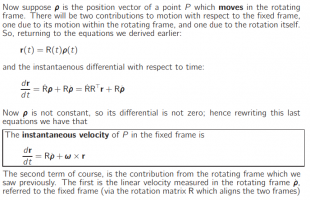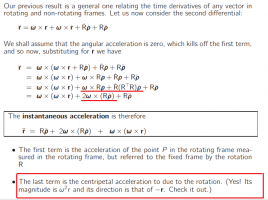Win_odd Dhamnekar
Junior Member
- Joined
- Aug 14, 2018
- Messages
- 212
Rotation: Part 2

Rotation: Part 3

Now in the Rotation: Part 3
How to prove that \(\displaystyle \omega \times R\dot{\rho} + \dot{R}(R^TR)\dot{\rho} = 2\omega \times (R\dot{\rho})\)
I know both terms are equal. But what kind of vector triple product algebra was used to make both terms equal?
My other question is how to prove that the magnitude and the direction of the last term of the instantaneous acceleration are \(\displaystyle \omega r^2 \) and -r respectively.

Rotation: Part 3

Now in the Rotation: Part 3
How to prove that \(\displaystyle \omega \times R\dot{\rho} + \dot{R}(R^TR)\dot{\rho} = 2\omega \times (R\dot{\rho})\)
I know both terms are equal. But what kind of vector triple product algebra was used to make both terms equal?
My other question is how to prove that the magnitude and the direction of the last term of the instantaneous acceleration are \(\displaystyle \omega r^2 \) and -r respectively.
Last edited:
